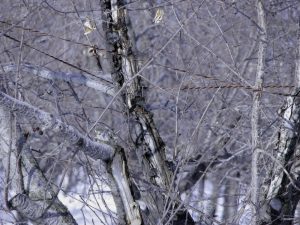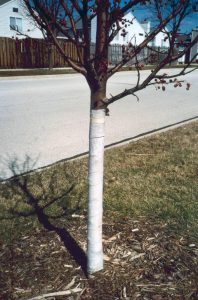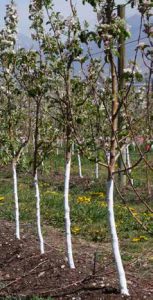General Chores
- Mow or rake fallen fruit to reduce pest pressure for next year.
- Mow tall weeds around trees to reduce rodent problems and deer rubbing.
- Make sure all new plantings get white paint (50% latex/50% water) from the base of the tree to scaffold limbs, to prevent sunscald.
- Irrigate this fall before the ground freezes.
- Prevent new coryneum blight (shothole infections this fall by applying copper to trees when 50% of the leaves have fallen. Use enough pressure to blow off existing leaves. (See below for more information.)
APPLE / PEAR
Fire Blight
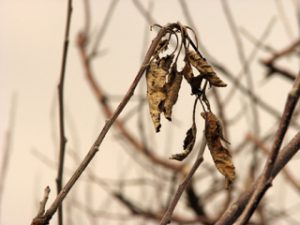
This fall, inspect trees and orchards for fire blight cankers. They are easy to spot because the leaves remain attached to the dead shoots.
The infected shoots should be pruned out when you conduct your normal late winter pruning.
At that time (when trees are dormant), it is not necessary to sterilize your pruners between cuts, and affected shoots and branches should be removed 10-12 inches below the visibly diseased tissue. If you are diligent about removing as much fire blight as possible, you are lessening the chances of an outbreak for next season.
PEACH / NECTARINE, CHERRY
Coryneum Blight
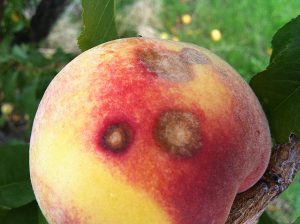
The time to treat coryneum blight on peach / nectarine is when 50% of leaves have dropped. Use a high-pressure sprayer to knock the rest of the leaves off the tree. Apply either:
- copper
- chlorothalonil
The reason to wait for 50% leaf drop is because cornyeum spores infect twigs through the new leaf scars in fall. So the fungicide spray should coat the tree so that the leaf scars are protected.
If any orchards or trees have severe infections, it will take at least three years of diligent fall, spring, and summer treatments to suppress the disease incidence.
Bacterial Canker
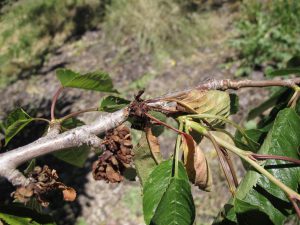
Bacterial canker (Pseudomonas syringae) is a disease of sweet cherry, causing oozing around dead buds, and twig and branch death.
Like coryneum blight, new infections enter trees through leaf scars in the fall. Research out of Oregon State University has shown that an application of copper in mid to late October can help reduce the incidence of this disease the following spring.
Sweet cherries that show oozing sap from dead buds and twigs, along with clusters of dead leaves or dead shoots, typically means an infection by bacterial canker.
OTHER FALL ORCHARD CHORES
Keep roots moist: At this time of year, leaves on trees are changing color and dropping, while underground, major root growth is occurring. So it is important to maintain adequate but not excessive soil moisture from now until the soil freezes for winter.
Do not fertilize now: Roots will continue to grow all through fall, but nutrient uptake essentially ceases after the leaves have dropped. It is too late for any fall fertilizer applications, as whatever is applied will leach out of the soil.
Prevent winter sunscald: In late winter, bark can be warmed by intense sunlight. If this warming is followed by a cold spell that night, the bark can be killed. Sunscald is one of the primary problems affecting young trees in Utah and is a major factor in the incidence of cytospora canker or flatheaded borers. Protect trunks by applying white tree wrap or painting the trunk and lower scaffold limbs with a 1:1 mixture of white latex paint to water. If using tree wrap, remove it in early April.
Tree removal: Trees suffering from significant insect, disease, or other problems should be removed now. There is still time to install replacement plantings this fall.
Protect from mice, voles: Create or maintain at least 3 feet of clear space from around the base of each tree to help minimize rodents from feeding on bark and roots. Young trees are particularly susceptible to girdling because their trunk circumference is so small. Consider installing a physical barrier around the trunk and down into the soil up to 6 inches.

